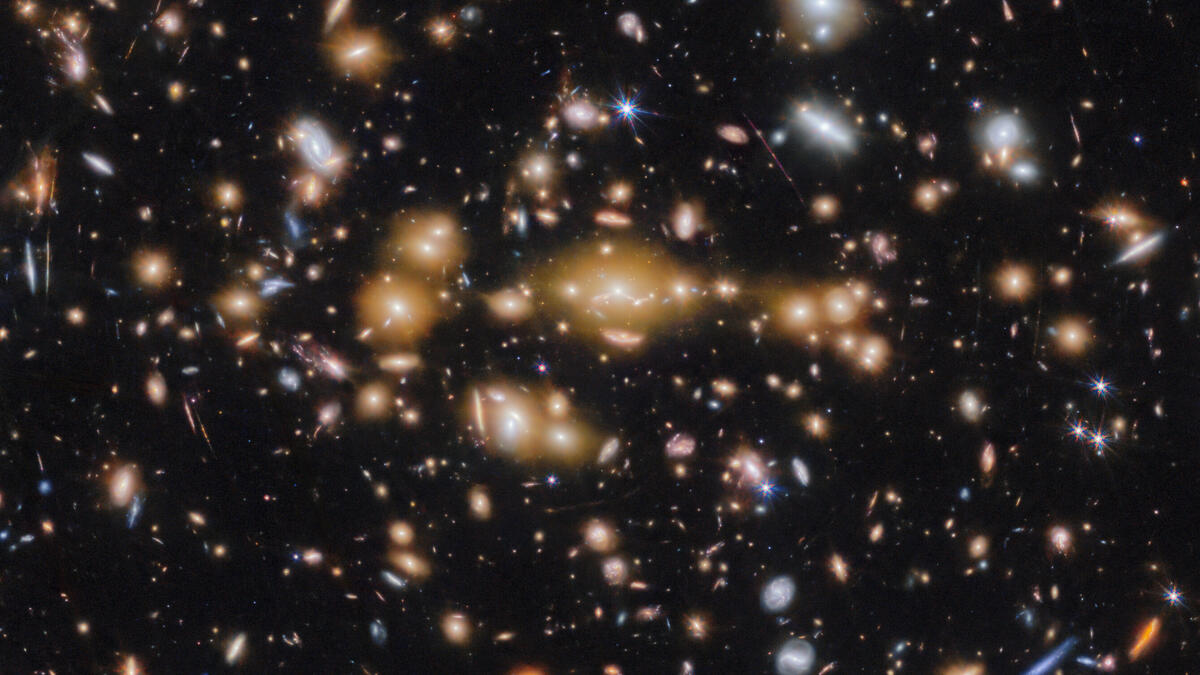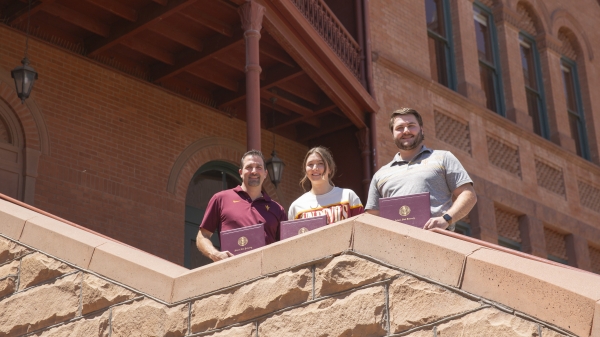Webb telescope reveals star clusters in Cosmic Gems arc
ASU researcher contributes to first discovery of star clusters in an infant galaxy formed less than 500M years after big bang

Galaxy cluster SPT-CL J0615−5746 (wide-field view). Image credit: ESA/Webb, NASA & CSA, L. Bradley (STScI), A. Adamo (Stockholm University) and the Cosmic Spring collaboration
Young galaxies in the early universe experienced significant bursts of star formation, producing large amounts of ionizing radiation. However, their great distances have made direct studies of their stellar content challenging.
Using the James Webb Space Telescope, an international team of astronomers, including Arizona State University Regents and Foundation Professor Rogier Windhorst, an interdisciplinary scientist for JWST, has now detected five young, massive star clusters in the Cosmic Gems arc (SPT0615-JD1), a strongly lensed galaxy emitting light from when the universe was approximately 460 million years old, spanning 97% of cosmic history.
These resultsThe data for these results were captured under Webb observing programme #4212 (PI: L. Bradley). have been published in Nature.
The Cosmic Gems arc was first discovered in images taken by the NASA/ESA Hubble Space Telescope as part of the RELICS, or Reionization Lensing Cluster Survey, program, which studied the lensing galaxy cluster SPT-CL J0615−5746.
With JWST, the science team can now see where stars formed and how they are distributed, in a similar way to how the Hubble Space Telescope is used to study local galaxies. The JWST view provides a unique opportunity to study star formation and the inner workings of infant galaxies at such an unprecedented distance.
“These galaxies are thought to be a prime source of the intense radiation that reionised the early universe,” said lead author Angela Adamo of Stockholm University and the Oskar Klein Centre in Sweden. “What is special about the Cosmic Gems arc is that thanks to gravitational lensing, we can actually resolve the galaxy down to parsec scales!”
“Webb's incredible sensitivity and angular resolution at near-infrared wavelengths, combined with gravitational lensing provided by the massive foreground galaxy cluster, enabled this discovery,” said Larry Bradley of the Space Telescope Science Institute and principal investigator of the JWST observing program that captured these data. "No other telescope could have made this discovery.”
In our Milky Way galaxy, we see ancient globular clusters of stars, which are bound by gravity and have survived for billions of years. These are old relics of intense star formation in the early universe, but it is not well understood where and when these clusters formed.
The detection of massive young star clusters in the Cosmic Gems arc provides us with an excellent view of the early stages of a process that may go on to form globular clusters. The newly detected clusters in the arc are massive, dense and located in a very small region of their galaxy, but they also contribute the majority of the ultraviolet light coming from their host galaxy. The clusters are significantly denser than nearby star clusters.
This discovery will help scientists to better understand how infant galaxies formed their stars and where globular clusters formed.
The team notes that this discovery connects a variety of scientific fields.
“These results provide direct evidence that indicates proto-globular clusters formed in faint galaxies during the reionization era, which contributes to our understanding of how these galaxies have succeeded in reionizing the universe,” Adamo said.
“This discovery also places important constraints on the formation of globular clusters and their initial properties. For instance, the high stellar densities found in the clusters provide us with the first indication of the processes taking place in their interiors, giving new insights into the possible formation of very massive stars and black hole seeds, which are both important for galaxy evolution,” she said.
In the future, the team hopes to build a sample of galaxies for which similar resolutions can be achieved.
“I am confident there are other systems like this waiting to be uncovered in the early universe, enabling us to further our understanding of early galaxies,” said Eros Vanzella from the Astrophysics and Space Science Observatory of Bologna in Italy, one of the main contributors to the work.
In the meantime, the team is preparing for further observations and spectroscopy with the James Webb Space Telescope.
“We plan to study this galaxy with Webb’s NIRSpec and MIRI instruments in Cycle 3,” Bradley said. “The NIRSpec observations will allow us to confirm the redshift of the galaxy and to study the ultraviolet emission of the star clusters, which will be used to study their physical properties in more detail. The MIRI observations will allow us to study the properties of ionized gas. The spectroscopic observations will also allow us to spatially map the star formation rate.”
“These are exactly the kind of observations at the end of the first light epoch that Webb was designed to do,” said Windhorst, a professor at ASU’s School of Earth and Space Exploration. “We fully expect that during its long lifetime, Webb will push these gravitationally lensed observations back into the epoch of the very first stars.”
Adapted from a European Space Agency release with contributions from ASU's School of Earth and Space Exploration.
More Science and technology

ASU researchers discuss the implications of deepfakes
Plato feared the artist.The ancient Greek philosopher, the original source of the notion that art imitates life, found imagery, at best, an entertaining illusion — at worst, a dangerous deception.In…

New ASU institute to create national cybersecurity hub
In 1788, 13-year-old Eugène-François Vidocq, the son of a wealthy merchant in Arras, France, stole his father’s set of silver plates. And so began a life of crime that resulted in dozens of…

From pizza pies to power plays: The rise of an engineering leader
Although he now holds the title of executive vice president of operations for Arizona Public Service Company, or APS, the largest electric company across the state, Jacob Tetlow had a humble…